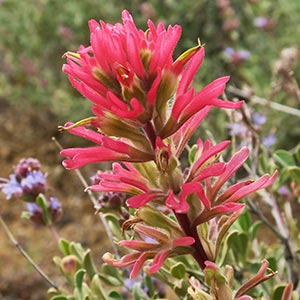Castilleja angustifolia
Castilleja pallescens
narrow-leaf paintbrush, northwestern Indian paintbrush, northwestern paintbrush, violet desert paintbrush
dwarf pale paintbrush, pale Indian paintbrush, pale paintbrush
few to many, ascending to erect, branched, especially near base, sometimes unbranched, hairs sparse to dense, spreading to retrorse, long, sometimes short, soft to stiff, usually mixed with short-glandular ones, sometimes viscid.
few to many, erect to ascending, decumbent at base, unbranched, sometimes branched, hairs moderately to very dense, retrorsely curved to appressed, short, ± stiff, eglandular.
brown or purplish, sometimes green, linear to lanceolate or broadly lanceolate, 1.2–7(–7.5) cm, not fleshy, margins plane, sometimes ± wavy, involute or flat, (0–)3–5-lobed, rarely with secondary lobes, apex acuminate to rounded;
lobes spreading, oblong or lanceolate to linear-lanceolate, apex acute to rounded.
purple-tinged or deep purple, sometimes green, linear to narrowly lanceolate, 1–4(–5) cm, not fleshy, margins plane, sometimes ± wavy, ± involute, (0–)3–5(–7)-lobed, apex acute;
lobes spreading or ascending-spreading, linear, apex acute.
2.5–20 × 1.5–5 cm;
bracts proximally greenish or dull purplish, distally pink, magenta, pink-purple, reddish pink, pale yellow, pale yellow-orange, pale orange, or white, rarely reddish or orange-red, lanceolate to oblong, 3–5(–9)-lobed, sometimes with secondary lobes;
lobes spreading or ascending, oblanceolate or linear, proximal lobes often much longer than distal, proximal lobes arising below or a little above mid length, apex acute to rounded.
(1.5–)4–8(–12) × 1.5–5.5 cm;
bracts pale green to yellow-green or reddish purple throughout, or proximally pale green to yellow-green, distally white to cream or pale yellowish, sometimes pink to reddish purple, lanceolate to linear-lanceolate, elliptic, or ovate, 3–5(–9)-lobed;
lobes spreading to ascending, linear, long, arising along distal 2/3, apex acute to obtuse.
straight, 18–27(–32) mm;
tube 8–17 mm;
beak usually long-exserted, adaxially green or pink, 8–15 mm;
abaxial lip deep green, reduced, inconspicuous, 1–2.5 mm, 5–20% as long as beak;
teeth incurved to ascending, deep green, 0.5–1.5 mm.
straight, 13–23(–27) mm;
tube 10–20 mm; subequal to calyx or beak slightly exserted;
beak adaxially whitish or buff, rarely pink to pink-purple, 3.5–8 mm;
abaxial lip proximally green, white, purple, or purplish brown, distally white, yellow, green, pink, or reddish, prominent, pouched, pouches pleated, longer than deep, gradually expanded, 2.5–8 mm, 70–100% as long as beak, puberulent;
teeth erect to spreading, pink, cream, or white, sometimes with a yellow spot proximally, 1.5–3.5 mm.
proximally green, yellow, brown, or purple, lobes colored as bract lobes, sometimes with a yellow band between proximal and distal parts, 13–25(–28) mm;
abaxial clefts 3–8 mm, adaxial 5–9(–12) mm, clefts 30–50% of calyx length, deeper than laterals, lateral (1–)1.5–4(–5) mm, 10–25% of calyx length;
lobes lanceolate to oblong, abaxials wider than adaxials, apex acute to rounded.
colored as bracts, sometimes distally purple with age, 11–25(–27) mm;
abaxial and adaxial clefts 7–13.6 mm, 40–50% of calyx length, deeper than laterals, lateral 0.5–4.3(–6) mm, (0–)5–25% of calyx length;
lobes lanceolate to triangular, apex usually triangular or acute, rarely ± obtuse.
= 24, 48.
Castilleja angustifolia
Castilleja pallescens
Varieties 3 (3 in the flora).
Much confusion exists concerning Castilleja angustifolia and the closely related C. chromosa. Sometimes C. chromosa is treated as a variety of C. angustifolia, using the name C. angustifolia var. dubia. The latter name is used here to represent a different assemblage of plants, not including C. chromosa. At other times, C. chromosa is synonymized completely under C. angustifolia. However, the two species are in most cases easily separable, and where they are sympatric there is little evidence of intergradation. Both C. angustifolia var. dubia and C. chromosa are accepted here. See additional comments under 3b. C. angustifolia var. dubia and 15. C. chromosa.
(Discussion copyrighted by Flora of North America; reprinted with permission.)
Varieties 2 (2 in the flora).
Castilleja pallescens occurs from valleys to alpine ridges and summits throughout its range, usually in sagebrush communities, but at higher elevations it is also found on dry sites associated with other plant species. The alpine plants are greatly reduced in stature.
(Discussion copyrighted by Flora of North America; reprinted with permission.)
1. Bracts distally usually pink to pink-purple; s Idaho, sw Montana, se Oregon, nw Wyoming. | var. angustifolia |
1. Bracts distally yellow, yellow-orange, pale orange, white, pink, reddish pink, or magenta; se Idaho, e Nevada, sw South Dakota, w Utah, ec Wyoming. | → 2 |
2. Bracts distally usually yellow to pale orange or white; ec Wyoming, adjacent sw South Dakota. | var. dubia |
2. Bracts distally usually yellow, yellow-orange, white, pink, or reddish pink; se Idaho, e Nevada, w Utah. | var. flavescens |
1. Bracts not rigid, veins inconspicuous, usually same color as surfaces; herbs (0.5–)1–3 dm; ne Idaho, sw Montana, nw Wyoming. | var. pallescens |
1. Bracts rigid, veins prominent, pale and contrasting with color of surfaces; herbs 0.4–1.2(–1.7) dm; s, se Idaho, ne Nevada, Oregon. | var. inverta |


